Linux Desktop CPU Roundup: Cutting Edge Penguin Performance
by Kristopher Kubicki on September 19, 2004 8:00 PM EST- Posted in
- Linux
DDR2 versus DDR1
There are very few real-world benchmarks that completely demonstrate total memory bandwidth saturation. For real world applications, latency becomes critical - or at least logic dictates. Below, you can see what happens to our Intel processors when we run them on DDR2 and DDR1. We used the same low latency Mushkin PC-3200 (2-2-2) that we used for the AMD testbed as our DDR1 kit. Low latencies are something that DDR2 modules lack right now; and even though our Corsair XMS2 memory operates at ~675MHz, the timings are less than spectacular 4-4-4.Let's take a look at a kernel compile - a typical memory and CPU hog.
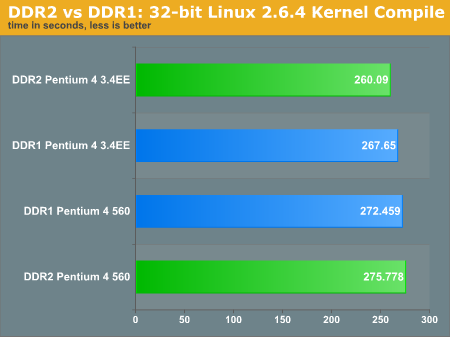
Below are the two different configurations of Intel processors running DDR1 and DDR2 during our Mental Ray 3.3.1 benchmark.
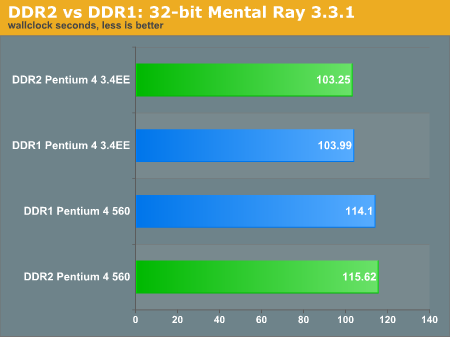
We are not really given a clear indication of which configuration runs better. The P4EE with DDR2 smidges past any other configuration, we expect more differentiation between the two. Let us look at some more content creation tests.
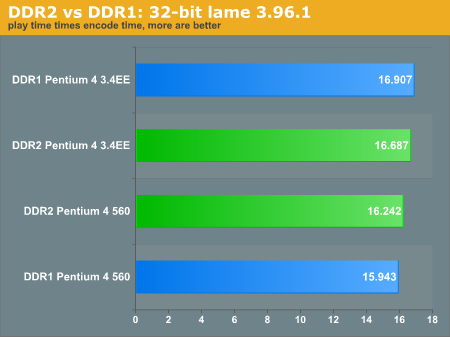
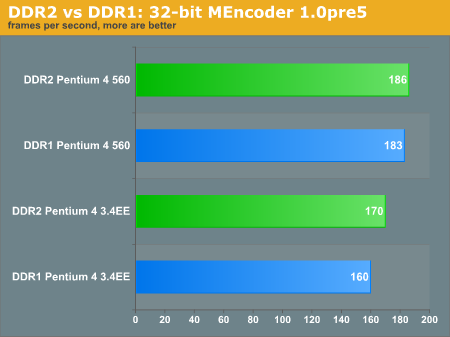
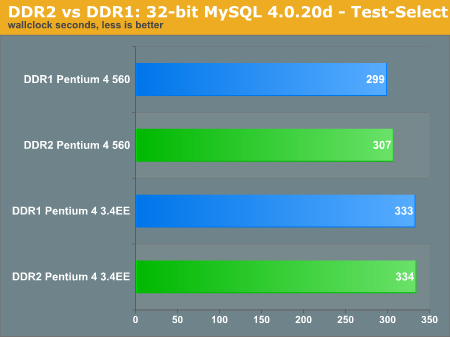
Notice that the MySQL test-select benchmark improves with DDR1 over DDR2. When we are making thousands of little queries to the database, we are relying more heavily on low latencies rather than the larger headroom of DDR2. However, consider our warning to take the sql-bench tests with a grain of salt. They do not entirely reflect SQL performance or workstation performance. The inconsistancy of which memory configuration from one benchmark to another definitely complicates issues. Price generally finishes the discussion for us.










33 Comments
View All Comments
Aquila76 - Monday, September 20, 2004 - link
It's happened again: the cheapest AMD64 939 processor is the better choice of the processors reviewed here for price/performance. Granted the Linux market isn't a huge chunk of the market for either company, but among those who do use Linux there is no reason to use anything but AMD.fitten - Monday, September 20, 2004 - link
It would be interesting to see these tests run on several S754 boxes as well. I know this one was entitled "cutting edge performance" but with the cost difference between the S939 solutions and the S754 solutions, many will opt (as I have) to go with the S754 parts. I run SuSE 9.1 Professional AMD64 on an Athlon 64 3000+ and have been pleased with it.Aquila76 - Monday, September 20, 2004 - link
This may be a little off-topic, but shows yet another reason California hates MS. This is what happens when you move to Windows...http://software.silicon.com/applications/0,3902465...
Love the caption: Someone forgot to reboot
fitten - Monday, September 20, 2004 - link
"Our processor test bed is completely caseless, and if we have issuse with our 3.6GHz processor out of a normal case, we can't imagine what issues might exist in a full enclosure. "Todays processors ("today" meaning back to the days of the original Pentium) typically run hotter with the case open than with it closed. With the case closed, cooler air is forced through the case and across the right places to help lower component temperatures, assuming that the fans are placed appropriately, are venting in the right direction, and cables/components are arranged to allow the air to flow properly.
Newer form factors, such as Intel's BTX, are designed in a large part to cope with cooling the thing down.
You should be running your test bed in a case with appropriate cooling.
Araemo - Monday, September 20, 2004 - link
A note about the compilation benchmark:Make and gcc themselves are not multi-threaded, but make does understand a -j option to specify the # of concurrent make jobs to run. The general rule-of-thumb I have heard, is to specify a -j equal to n+1, where n is the number of processors in the system(One compile job per processor, and one control job.) So, to test if hyperthreading lowers the compile time, specifiy `time make -j 3`.
I would personally like to see this, in addition to the single-threaded results. I read some quick-and-dirty benchmark results suggesting hyperthreading does help the compile time, but those results were published by curious people when hyperthreading was new.. I haven't seen any results on recent processors.
garfield - Monday, September 20, 2004 - link
Isn't it normal procedure for a P4 that's getting too hot that it throttles the clock speed down? Maybe that would explain the extremely bad results, though it seems a bit unrealistic that the results has been reproducible, unless each iteration of the benchmark has been run for a long time.ceefka - Monday, September 20, 2004 - link
First of all : good article. It really shows the early benefits of well written 64-bit software. The 3500+ is definately on my wishlist ;-)"This does not bode well for the processor. Our processor test bed is completely caseless, and if we have issues with our 3.6GHz processor out of a normal case, we can't imagine what issues might exist in a full enclosure."
Rather confusing this bit, Kristopher. Anyway, I read that a good case will offer convection which apparently a caseless testbed does not. How were the tempratures of the other CPU's? Were they also a tad above average or typical peak?
balzi - Monday, September 20, 2004 - link
Some thoughts --can we please have Graphs where the order of the legend is the same as the order of the bars in the bar-graph. Surely that's possible.
also, the strange "Thermal issue" error. It seems that you thought it was weird but immediately assumed that it was correct; that the Intel CPU(s) were getting too hot.
Did you verify this somehow?? It seems strange to call it "An unusual problem" and then trust that it's correct without question or explanation.
Thanks
Shinei - Monday, September 20, 2004 - link
"This does not bode well for the processor. Our processor test bed is completely caseless, and if we have issuse with our 3.6GHz processor out of a normal case, we can't imagine what issues might exist in a full enclosure."That quote made me laugh, and I'm not entirely sure why. :D
Anyway, I see that going to 64-bit is definitely worth the price of admission, considering the huge gains the processors get in the jump. One thing I had a question on, though: Why does the result from the SSL benchmark halve between 32-bit and 64-bit? Is it that the keys are longer in 64-bit?
gherald - Monday, September 20, 2004 - link
I too would prefer longer images that include both 32 and 64-bit results. Mouseover comparisons are cumbersome.Is sample.wav 800mb or 700mb? I'm guessing the 7 was probably just a typo.
Nice analysis of DDR1 vs 2.
My only gripe is I wish a full complement of "lower end" processors were included in all these benchmarks (754s, slower prescotts, and heck even northwoods)... but I guess that'd be too much work.